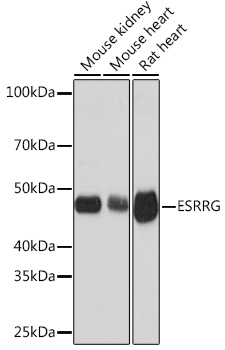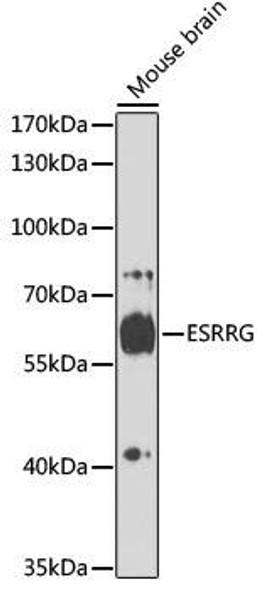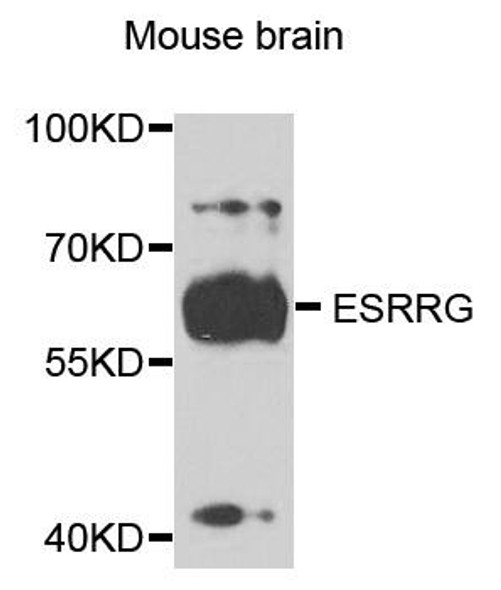Epigenetics & Nuclear Signaling Antibodies 5
Anti-ESRRG Antibody (CAB9606)
- SKU:
- CAB9606
- Product Type:
- Antibody
- Reactivity:
- Human
- Reactivity:
- Mouse
- Reactivity:
- Rat
- Host Species:
- Rabbit
- Isotype:
- IgG
- Antibody Type:
- Monoclonal Antibody
- Research Area:
- Epigenetics and Nuclear Signaling
Description
| Antibody Name: | Anti-ESRRG Antibody |
| Antibody SKU: | CAB9606 |
| Antibody Size: | 20uL, 50uL, 100uL |
| Application: | WB |
| Reactivity: | Human, Mouse, Rat |
| Host Species: | Rabbit |
| Immunogen: | A synthesized peptide derived from human ESRRG |
| Application: | WB |
| Recommended Dilution: | WB 1:500 - 1:2000 |
| Reactivity: | Human, Mouse, Rat |
| Positive Samples: | Mouse kidney, Mouse heart, Rat heart |
| Immunogen: | A synthesized peptide derived from human ESRRG |
| Purification Method: | Affinity purification |
| Storage Buffer: | Store at -20'C. Avoid freeze / thaw cycles. Buffer: PBS with 0.02% sodium azide, 0.05% BSA, 50% glycerol, pH7.3. |
| Isotype: | IgG |
| Sequence: | Email for sequence |
| Gene ID: | 2104 |
| Uniprot: | P62508 |
| Cellular Location: | |
| Calculated MW: | 51kDa |
| Observed MW: | 50KDa |
| Synonyms: | ERR3, ERRgamma, NR3B3 |
| Background: | This gene encodes a member of the estrogen receptor-related receptor (ESRR) family, which belongs to the nuclear hormone receptor superfamily. All members of the ESRR family share an almost identical DNA binding domain, which is composed of two C4-type zinc finger motifs. The ESRR members are orphan nuclear receptors; they bind to the estrogen response element and steroidogenic factor 1 response element, and activate genes controlled by both response elements in the absence of any ligands. The ESRR family is closely related to the estrogen receptor (ER) family. They share target genes, co-regulators and promoters, and by targeting the same set of genes, the ESRRs seem to interfere with the ER-mediated estrogen response in various ways. It has been reported that the family member encoded by this gene functions as a transcriptional activator of DNA cytosine-5-methyltransferases 1 (Dnmt1) expression by direct binding to its response elements in the DNMT1 promoters, modulates cell proliferation and estrogen signaling in breast cancer, and negatively regulates bone morphogenetic protein 2-induced osteoblast differentiation and bone formation. Multiple alternatively spliced transcript variants have been identified, which mainly differ at the 5' end and some of which encode protein isoforms differing in the N-terminal region. [provided by RefSeq, Aug 2011] |
| UniProt Protein Function: | ERR3: Orphan receptor that acts as transcription activator in the absence of bound ligand. Binds specifically to an estrogen response element and activates reporter genes controlled by estrogen response elements. Belongs to the nuclear hormone receptor family. NR3 subfamily. 3 isoforms of the human protein are produced by alternative splicing. |
| UniProt Protein Details: | Protein type:DNA-binding; Transcription factor; Nuclear receptor Chromosomal Location of Human Ortholog: 1q41 Cellular Component: nucleoplasm Molecular Function:AF-2 domain binding; protein binding Biological Process: positive regulation of transcription, DNA-dependent; regulation of transcription, DNA-dependent; transcription initiation from RNA polymerase II promoter |
| NCBI Summary: | This gene encodes a member of the estrogen receptor-related receptor (ESRR) family, which belongs to the nuclear hormone receptor superfamily. All members of the ESRR family share an almost identical DNA binding domain, which is composed of two C4-type zinc finger motifs. The ESRR members are orphan nuclear receptors; they bind to the estrogen response element and steroidogenic factor 1 response element, and activate genes controlled by both response elements in the absence of any ligands. The ESRR family is closely related to the estrogen receptor (ER) family. They share target genes, co-regulators and promoters, and by targeting the same set of genes, the ESRRs seem to interfere with the ER-mediated estrogen response in various ways. It has been reported that the family member encoded by this gene functions as a transcriptional activator of DNA cytosine-5-methyltransferases 1 (Dnmt1) expression by direct binding to its response elements in the DNMT1 promoters, modulates cell proliferation and estrogen signaling in breast cancer, and negatively regulates bone morphogenetic protein 2-induced osteoblast differentiation and bone formation. Multiple alternatively spliced transcript variants have been identified, which mainly differ at the 5' end and some of which encode protein isoforms differing in the N-terminal region. [provided by RefSeq, Aug 2011] |
| UniProt Code: | P62508 |
| NCBI GenInfo Identifier: | 50402102 |
| NCBI Gene ID: | 2104 |
| NCBI Accession: | P62508.1 |
| UniProt Secondary Accession: | P62508,O75454, O96021, Q68DA0, Q6P274, Q6PK28, Q6TS38 A8K4I0, A8K6I2, B3KY84, E9PGB7, F8W8J3, |
| UniProt Related Accession: | P62508 |
| Molecular Weight: | 52,462 Da |
| NCBI Full Name: | Estrogen-related receptor gamma |
| NCBI Synonym Full Names: | estrogen related receptor gamma |
| NCBI Official Symbol: | ESRRG |
| NCBI Official Synonym Symbols: | ERR3; NR3B3; ERRgamma |
| NCBI Protein Information: | estrogen-related receptor gamma |
| UniProt Protein Name: | Estrogen-related receptor gamma |
| UniProt Synonym Protein Names: | ERR gamma-2; Estrogen receptor-related protein 3; Nuclear receptor subfamily 3 group B member 3 |
| Protein Family: | Estrogen-related receptor |
| UniProt Gene Name: | ESRRG |
| UniProt Entry Name: | ERR3_HUMAN |
View AllClose







